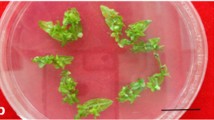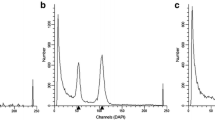Abstract
Tetraploid plants of Zizyphus jujuba Mill. cv. Zhanhua were obtained with in vitro colchicine treatment. Shoot tips from in vitro-grown plants were treated with five different concentrations of colchicine (0.01, 0.03, 0.05, 0.1, 0.3%) in liquid MS medium (Murashige and Skoog 1962), and shaken (100 rpm) at 25 °C in darkness for 24, 48, 72 or 96 h, respectively. Tetraploids were obtained at a frequency of over 3% by using 0.05% colchicine (48 h, 72 h) and 0.1% colchicine (24 h, 48 h) treatment as determined by flow cytometry. Cytological and morphological evidence confirmed the results of flow cytometric analysis. The chromosome number of diploid plants was 24 and that of tetraploid plants was 48. The stomata sizes of tetraploid plants were significantly larger than those of diploid plants, while the frequency of stomata were reduced significantly. Similarly, the chloroplast number of guard cells of tetraploid plants increased significantly. The selected tetraploid plants were grafted onto mature trees of Z. jujuba Mill. cv. Zhanhua in the field, resulted in thicker stems, rounder and succulent leaves, larger flowers and a delay in florescence time (3–4 days later) than diploid plants.






Similar content being viewed by others
Abbreviations
- BA :
-
Benzylaminopurine
- GA 3 :
-
Gibberellic acid
- IAA :
-
Indole-3-acetic acid
- IBA :
-
Indole-3-butyric acid
- MS :
-
Murashige and Skoog (1962) medium
References
Aryavand A, Ehdaie B, Tran B, Waines JG (2003) Stomata frequency and size differentiate ploidy levels in Aegilops neglecta. Genet Res Crop Evol 50:175–182
Borrino EM, Powell W (1988) Stomata guard cell length as an indicator of ploidy in microspore-derived plants of barley. Genome 30:158–160
Chen ZL, Yan ZL, Xue H, Feng XD, Chen GL, Cao JY (2002) In vitro culture of leaves and plantlet regeneration of Zizyphus jujuba var Zhanhua-Dongzao. Plant Physiol Commun 38:584
Cohen D, Yao JL (1996) In vitro chromosome doubling of nine Zantedeschia cultivars. Plant Cell Tissue Organ Cult 47:43–49
Derman H (1954) Colchiploidy in grapes. J Hered 45:159–172
Derman H (1965) Colchiploidy and histological imbalance in triploid apple and pear. Am J Bot 52:353–359
Dewey DR (1980) Some applications and misapplications of induced polyploidy to plant breeding. In: Lewis WH (ed) Polyploidy-biological relevance. Plenum Press, New York, pp 445–489
Evans WD (1982) Guelph SO1 synthetic octoploid strawberry breeding clone. Hort Sci 17:833–834
Gu XF, Zhang JR (2005) An efficient adventitious shoot regeneration system for Zhanhua winter jujube (Zizyphus jujuba Mill.) using leaf explants. Plant Cell Rep 23:775–779
Hamill SD, Smith MK, Dodd WA (1992) In vitro induction of banana autotetraploidy by colchicine treatment of micropropagated diploids. Aust J Bot 40:887–896.
James DJ, Mackenzie KAD, Malhotra SB (1987) The induction of hexaploidy in cherry rootstocks using in vitro regeneration techniques. Theor Appl Genet 73:589–594
Kadota M, Niimi Y (2002) In vitro induction of tetraploid plants from a diploid Japanese pear cultivar (Pyrus pyrifolia N. cv. Hosui). Plant Cell Rep 21:282–286
Li HW, Feng SQ, Zhao YM (1999) Primary study on the storage of Chinese jujube dongzao. J Shanxi Agric Sci 27:65–67
Liu P, Xue HZ, Zhou XY, Liu MJ, Mao YM, Zhou JY (2004) Study on the biological basis of pollination in Chinese jujube (Zizyphus jujuba) and wild jujube (Z. spinosa). J Fruit Sci 21:224–228
Liu QZ, Zhao HJ, Liu P, Mong RG, Freddi H (2001) Regeneration of tetraploid plants of royal gala apple variety from in vitro leave treated with colchicine. J Fruit Sci 18:7–10
Masterson J (1994) Stomatal size in fossil plants:evidence for polyploidy in majority of angiosperms. Science 264:421–424
Mathur N, Ramawat KG, Nandwani D (1995) Rapid in vitro multiplication of jujube through mature stem explants. Plant Cell Tissue Organ Cult 43:75–77
Murashige T, Skoog F (1962) A revised medium for rapid growth and bioassays with tobacco tissue cultures. Physiol Plant 15:473–497
Nitsch JP (1969) Experimental androgenesis in Nicotiana. Phytomorphology 19:389–404
Perry JL, Lyrene PM (1984) In vitro induction of tetraploidy in Vaccinium darrowi, V. elliottii and V. darrowi × V. elliottii with colchicines treatment. J Am Soc Hort Sci 109:4–6
Predieri S (2001) Mutation induction and tissue culture in improving fruits. Plant Cell Tissue Organ Cult 64:185–210
Sanford JC (1983) Ploidy manipulations. In: Moore JN, Janick J (eds) Methods in fruit breeding. Purdue University Press, West Lafayette, pp 100–123
Sari N, Abak K, Pitrat M (1999) Comparison of ploidy level screening methods in watermelon: Citrullus lanatus (Thunb.) Matusum. and Nakai. Sci Hortic 82:265–277
Sebastiampillai AR, Jones JK (1976) Improved techniques for the induction and isolation of polyploids in the genus Fragaria. Euphytica 25:725–735
Van DM, Morpurgo R, Dolezel J, Afza R (1996) Induction and verification of autotetraploids in diploid banana (Musa acuminata) by in vitro techniques. Euphytica 88:25–34
Yang J (2001) The formation and evolution of polyploid genomes in plants. Acta Phytol Sin 39:357–371
Yudanova SS, Maletskaya EI, Maletskii SI (2002) Variability of chloroplast number in populations of stomatal guard cells in sugar beet Beta vulgaris L. Russ J Genet 38:72–78
Zhao J, Liu MJ (2003) RAPD analysis on the outstanding clones of Zanhuadazao and Zanxindazao. Sci Silvae Sin 39:153–156
Acknowledgments
This research was supported by the National Natural Science Foundation of China (30300242), the project of Department of Science and Technology of Shandong and the China Postdoctoral Science Foundation
Author information
Authors and Affiliations
Corresponding author
Additional information
Communicated by P. Ozias-Akins
Rights and permissions
About this article
Cite this article
Gu, X.F., Yang, A.F., Meng, H. et al. In vitro induction of tetraploid plants from diploid Zizyphus jujuba Mill. cv. Zhanhua. Plant Cell Rep 24, 671–676 (2005). https://doi.org/10.1007/s00299-005-0017-1
Received:
Revised:
Accepted:
Published:
Issue Date:
DOI: https://doi.org/10.1007/s00299-005-0017-1




